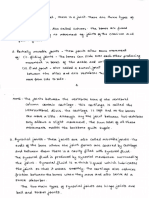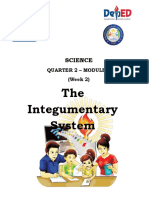Locomotion and Movement
Locomotion and Movement
Uploaded by
YouTutor PSCopyright:
Available Formats
Locomotion and Movement
Locomotion and Movement
Uploaded by
YouTutor PSCopyright
Available Formats
Share this document
Did you find this document useful?
Is this content inappropriate?
Copyright:
Available Formats
Locomotion and Movement
Locomotion and Movement
Uploaded by
YouTutor PSCopyright:
Available Formats
3 MUSCLES
About 40-50% of the body weight of an adult human is by muscles.
contributed
mesoderm.
Muscle is a specialised tissue, that arises from the
Muscles show special properties like excitability, contractility, extensibility and
elasticity.
Muscles have been classified using criteria like () location, (i) appearance/morphology
and (iü) nature of regulation of their ectivities.
In humans, the muscles are broadly classified into three categories, as given below:
Muscles
Skeletal/ Smooth/ Cardiac
Striated muscles Non-striated muscles muscles
() Striations are prominent Striations are absent. Striations are faint.
(i) Voluntary in function Involuntary in function. Involuntary in function
(i) Cells are multinucleate. Cells are uninucleate. Cells are uninucleate.
(iv) Fibres are cylindrical Fibres are spindle shaped. Fibres are cylindrical.,
and unbranched. branched and show
intercalated discs.
(v) Innervated by voluntary Innervated by autonomic Innervated by autonomic
nervous system. nervous system. nervous system
(not directly).
e.g., Muscles of. limbs Muscles of visceral organs. Heart muscles
Phalanges
19. JOINTS
Fig. 20.14 Pelvic Girdle
articulation between two or
A joint is a place of and Hindlimb
more bones or between a
bone and a cartilage.
to carry out movements
The force generated by the contraction of muscles is used
fulcrumn.
through joints, which act as
classified into the following three types:
Depending on the movability, the joints are
) Fibrous joints or immovable joints Frontal bone
In these joints, the articulating bones are Sutures
held with the help of white
very tightly
Parietal bone
fibrous connective tissue, in the form of
sutures.
e.g., sutures between the skull bones. Occipital bone.
Articulation of roots of teeth with the 20.15 Fixed Joints of Bones
Fig.
sockets of jaw bones. of. Cranium
(i) Cartilaginous joints or slightly movable joints
In such joints, the articulation of bones Centrum
allows for very litter movement.
The opposing surfaces of the bones are Cartilage
connected by fibrocartilage. Articulating
vertebrae in the surface
eg. Joints between adjacent
vertebral column. Fig. 20.16 Cartilagenous Joints
(1:) Sunovial joints or
freely movable
This type of joints
joints allows extensive
movements theof
articulating Ligament
bones upon each other.
These joints are
characterised
Synoval fud Anouar
the presence of a by catiage
fluid-filled cavity Synaval
membrane
between the articulating bones. -Pervs
The cavity is filled with a
and slippery fluid called viscous
fluid, which reduces the synovial
between the bones during
friction
cems
movement.
Fig. 20.17 Ball and
The Socket Joint
following are the
different types of
a. Ball and socket synovial joints
joint e.g. between humerus and
femur and pelvic girdle pectoral girdle. between
b. Hinge joint e.g. knee joint and elbow
C. Pivot joint e.g. between atlas and joint
d. occipital condyles
Gliding joints e.g. betweern the carpals, between the tarsals
e. Saddle joints e.g. between
carpal and metacarpals
of thumb
20. DISORDERS OF BONES AK
()Arthritis : It is the inffammation of joints.
(17) Osteoporsis: It is
age dependent disorder of the bones, characterised by low bone
an
mass, deterioration of the microarichitecture of the bone and increased
fragility.
(ii) Gout : It is the inflammation of the joints due to excess accumulation of uric acid.
You might also like
- Dynamic Ligaments The Revolutionary Re-Vision of Jaap Van Der Wal 2011 EN Article PDFDocument6 pagesDynamic Ligaments The Revolutionary Re-Vision of Jaap Van Der Wal 2011 EN Article PDFJorge Flores TorresNo ratings yet
- JointsDocument5 pagesJointsSEAN JODI M. COSEPENo ratings yet
- Reviewer For Skeletal and Muscular SystemDocument9 pagesReviewer For Skeletal and Muscular SystemKhan KhanNo ratings yet
- Week 9 Revised Ap1 Lecture Joints V24-25Document39 pagesWeek 9 Revised Ap1 Lecture Joints V24-25ks32016No ratings yet
- The JointsDocument7 pagesThe JointsrazondiegoNo ratings yet
- SEDS11 Bones Worksheet AnswersDocument13 pagesSEDS11 Bones Worksheet Answersjeffersonmanalo787No ratings yet
- Art HR OlogyDocument42 pagesArt HR OlogyjovinkasimirNo ratings yet
- W2 Fundamental Principles For PE of Musculoskeletal System (Gomez)Document22 pagesW2 Fundamental Principles For PE of Musculoskeletal System (Gomez)Jane de VriesNo ratings yet
- JointsDocument33 pagesJointsDeshmukh KrishnaNo ratings yet
- Ana - Joints ClassificationsDocument12 pagesAna - Joints ClassificationsMahmoud hilmyNo ratings yet
- 11.2 Movement: Essential Idea: The Roles ofDocument20 pages11.2 Movement: Essential Idea: The Roles ofReshma DookarranNo ratings yet
- Skeletal System - KODocument1 pageSkeletal System - KOGift Munyinda (G-Man)No ratings yet
- Joints Cliff Notes A&pDocument4 pagesJoints Cliff Notes A&pdbelmerNo ratings yet
- Skeletal System PT 3 Fill in Student kd15Document3 pagesSkeletal System PT 3 Fill in Student kd15Julia MendelsonNo ratings yet
- JointsDocument2 pagesJointsBritney MagbanuaNo ratings yet
- GSA HumanPhysiologyDocument13 pagesGSA HumanPhysiologyNimra FirdousNo ratings yet
- Joints Anatomy (Ashalatha)Document16 pagesJoints Anatomy (Ashalatha)Abdul KhadirNo ratings yet
- Anatomy of JointsDocument5 pagesAnatomy of JointsJayson CastroNo ratings yet
- 3.1 Skeletal SystemDocument17 pages3.1 Skeletal SystemAndriy GarcíaNo ratings yet
- Lesson 4 - JointsDocument5 pagesLesson 4 - JointsMuffaddal MustafaNo ratings yet
- Musculoskeletal System. Assessing The MusculoskeletalDocument11 pagesMusculoskeletal System. Assessing The MusculoskeletalLorenz Jude CańeteNo ratings yet
- Movement in HumansDocument35 pagesMovement in HumansLakeysha AlauraNo ratings yet
- 2.1 (B) - Role of Muscles, Ligaments & Tendons inDocument19 pages2.1 (B) - Role of Muscles, Ligaments & Tendons inliefeng81100% (1)
- JointsDocument22 pagesJointswazzupwaleedNo ratings yet
- 1 - Joints and Their Classifications (Student)Document26 pages1 - Joints and Their Classifications (Student)neha.garuguNo ratings yet
- A Joint Less Ordinary Intriguing Roles For HedgehoDocument18 pagesA Joint Less Ordinary Intriguing Roles For HedgehoShameena KnNo ratings yet
- Lesson 5 - Synovial JointDocument3 pagesLesson 5 - Synovial JointMuffaddal MustafaNo ratings yet
- 5 - ArthrologyDocument26 pages5 - Arthrologydrshubhamvyas.08No ratings yet
- Anatomy Medical TerminologyDocument12 pagesAnatomy Medical TerminologyNikita GosineNo ratings yet
- BIOS1168 Functional Musculoskeletal Anatomy ADocument23 pagesBIOS1168 Functional Musculoskeletal Anatomy ALachlan NguyenNo ratings yet
- Sport Science NotesDocument5 pagesSport Science NotesSpicyChildrenNo ratings yet
- Note, Unit 5 Topic 7B, Muscle, Movement and HeartDocument24 pagesNote, Unit 5 Topic 7B, Muscle, Movement and HeartNour AtassiNo ratings yet
- 01introduction SkeletonDocument12 pages01introduction Skeletonapi-19641337No ratings yet
- Types of JointsDocument3 pagesTypes of JointsNirvan RampersadNo ratings yet
- Classification of Joints-Dr - GosaiDocument10 pagesClassification of Joints-Dr - GosaiDr.B.B.GosaiNo ratings yet
- GCSE PE Paper 1 ContentDocument18 pagesGCSE PE Paper 1 Contentshiven.solankiNo ratings yet
- JOINTSDocument24 pagesJOINTSNatukunda DianahNo ratings yet
- Chapter 5iDocument20 pagesChapter 5iMuhd HafizzudinNo ratings yet
- Classificationofjoints 140413054157 Phpapp01 161023170805Document49 pagesClassificationofjoints 140413054157 Phpapp01 161023170805Adu-danquah StephenNo ratings yet
- Chapter 13 Ana LabDocument15 pagesChapter 13 Ana LabJyrus Quim CrusperoNo ratings yet
- Ln.10 SKELETON-Movement and Locomotion - NotesDocument5 pagesLn.10 SKELETON-Movement and Locomotion - Noteshiteshseema2008No ratings yet
- Homework 6 - JointsDocument5 pagesHomework 6 - JointsAdwoa OkohNo ratings yet
- Type of JointsDocument51 pagesType of JointsZainab AshroffNo ratings yet
- JointsDocument18 pagesJointsKhadijah MehmoodNo ratings yet
- Anatomy Sendi WebDocument10 pagesAnatomy Sendi WebazimahakimNo ratings yet
- Joints NotesDocument2 pagesJoints NotesDeva ChiruNo ratings yet
- JointsDocument78 pagesJointskalejaiyekhalid33No ratings yet
- Pna Midterm Prep: Joints Classification of Joints:: Synovial Cavity Connective Tissue Fibrous JointsDocument4 pagesPna Midterm Prep: Joints Classification of Joints:: Synovial Cavity Connective Tissue Fibrous JointsaamenaNo ratings yet
- Health Assessment-Finals: Assessing Musculoskeletal SystemDocument12 pagesHealth Assessment-Finals: Assessing Musculoskeletal Systemelena ampatinNo ratings yet
- Anaphy Reviewer Muscular SystemDocument4 pagesAnaphy Reviewer Muscular SystemJoyce Kathreen Ebio LopezNo ratings yet
- Joints 9.9.2021Document16 pagesJoints 9.9.202121120072No ratings yet
- 2 ArthrologyDocument30 pages2 ArthrologyAbhijith S. PNo ratings yet
- The Infrapatellar Fat Pad in The KneeDocument10 pagesThe Infrapatellar Fat Pad in The KneeDeogracias S. Espiritu IINo ratings yet
- Synovial JointsDocument4 pagesSynovial JointsminhchauNo ratings yet
- Act. 4d Joints Body Movements FOR STUDENTSDocument9 pagesAct. 4d Joints Body Movements FOR STUDENTSShane SayconNo ratings yet
- Advanced farriery knowledge: A study guide and AWCF theory course companionFrom EverandAdvanced farriery knowledge: A study guide and AWCF theory course companionNo ratings yet
- Encyclopaedia Britannica, 11th Edition, Volume 15, Slice 5 "Joints" to "Justinian I."From EverandEncyclopaedia Britannica, 11th Edition, Volume 15, Slice 5 "Joints" to "Justinian I."No ratings yet
- Encyclopaedia Britannica, 11th Edition, Volume 15, Slice 5 "Joints" to "Justinian I."From EverandEncyclopaedia Britannica, 11th Edition, Volume 15, Slice 5 "Joints" to "Justinian I."No ratings yet
- Respiration in PlantsDocument6 pagesRespiration in PlantsYouTutor PSNo ratings yet
- Plant Growth and DevelopmentDocument2 pagesPlant Growth and DevelopmentYouTutor PSNo ratings yet
- Neural Control and Coordination NOTESDocument8 pagesNeural Control and Coordination NOTESYouTutor PSNo ratings yet
- Excretory Products and Their EliminationDocument11 pagesExcretory Products and Their EliminationYouTutor PSNo ratings yet
- Breathing and Exchange of GasesDocument7 pagesBreathing and Exchange of GasesYouTutor PSNo ratings yet
- Body Fluids and CirculationDocument13 pagesBody Fluids and CirculationYouTutor PSNo ratings yet
- Chapter 11-Human Body SystemDocument48 pagesChapter 11-Human Body SystemTrần MạnhNo ratings yet
- Term 3 Life Science Remote Learning BookletDocument57 pagesTerm 3 Life Science Remote Learning BookletAgrarianNo ratings yet
- Sci6 Q2 Module3 Version3Document46 pagesSci6 Q2 Module3 Version3Melecio jr HimaganNo ratings yet
- Class 9 Worksheet (Bio)Document2 pagesClass 9 Worksheet (Bio)aditiNo ratings yet
- Module 5 - The Human BodyDocument28 pagesModule 5 - The Human BodyRonald Michael QuijanoNo ratings yet
- Structural Organisation in Animals NCERT Line by LineDocument13 pagesStructural Organisation in Animals NCERT Line by Linerajshelke2799No ratings yet
- Linfa PerifericaDocument10 pagesLinfa PerifericaMirtaNo ratings yet
- The Dental Pulp and Periradicular TissuesDocument43 pagesThe Dental Pulp and Periradicular TissuesmirfanulhaqNo ratings yet
- 5090 - Topic6 - Bio - Transport in Flowering PlantsDocument32 pages5090 - Topic6 - Bio - Transport in Flowering PlantsMaryam ShahidNo ratings yet
- Class6 Science Basics of Biology WorksheetDocument5 pagesClass6 Science Basics of Biology WorksheetsjiaahhsusgshuNo ratings yet
- Science6 Q2 W2 1Document9 pagesScience6 Q2 W2 1Matt The idkNo ratings yet
- TISSUESDocument12 pagesTISSUESMaria Stephanie LabutapNo ratings yet
- Morphofunction Development of The White Rat Thymus in Postnatal OntogenesisDocument5 pagesMorphofunction Development of The White Rat Thymus in Postnatal OntogenesisCentral Asian StudiesNo ratings yet
- Active Recall WorksheetDocument9 pagesActive Recall Worksheetanweshaasingh22No ratings yet
- Finals in Forensic 1Document9 pagesFinals in Forensic 1RALPH REVIN MALOONNo ratings yet
- LepidodendronDocument4 pagesLepidodendronSrijanNo ratings yet
- ClinicalDocument2 pagesClinicalanne laureNo ratings yet
- Group Assignment-Report Basic Human Anatomy-Sec69Document20 pagesGroup Assignment-Report Basic Human Anatomy-Sec69ALYAA NATASHA (BG)No ratings yet
- Worksheet of Human Reproductive SystemDocument3 pagesWorksheet of Human Reproductive SystemMaria LorraineNo ratings yet
- Sankalp Sanjeevani NEET 2024: ZoologyDocument12 pagesSankalp Sanjeevani NEET 2024: ZoologyKey RavenNo ratings yet
- DPP-Locomotion and MovementDocument6 pagesDPP-Locomotion and MovementKisna guptaNo ratings yet
- Module 2Document10 pagesModule 2Renee Andrei Concepcion MozarNo ratings yet
- Medical Terminology NotesDocument24 pagesMedical Terminology NotesKoala KrushNo ratings yet
- Vanita JadhavDocument4 pagesVanita Jadhavartemis 0516No ratings yet
- Chynn Assignments LewlDocument8 pagesChynn Assignments LewlFrancynn ManliguezNo ratings yet
- Biology-Xi Term-01Document6 pagesBiology-Xi Term-01lightbulbfancoolerNo ratings yet
- CBL Lesson PlanDocument3 pagesCBL Lesson PlankhysophNo ratings yet
- GinkoDocument38 pagesGinkoIzzy ChanNo ratings yet
- Class 9 TissueDocument10 pagesClass 9 Tissuekhatridheeraj657No ratings yet
- Phleb Review QuestionsDocument76 pagesPhleb Review QuestionsHeily NicoleNo ratings yet































































































